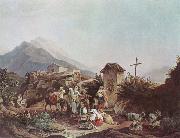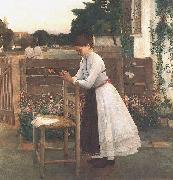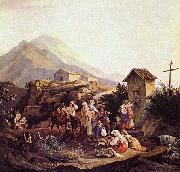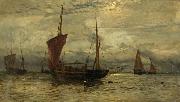Wholesale Oil Painting Reproductions No Minimum and Door to Door! |
|||||||||||
|
|
|||||||||||

|
|||||||||||
|
|
|
||||||||
All Adrian Ludwig Richter Oil Paintings |
||||||||
|
|
||||||||
|
|
||||||||
|
Artist Introduction: German, 1803-1884
German painter, printmaker and illustrator. He ranks with Moritz von Schwind as the most important representative of late Romantic painting and printmaking in Germany. In contrast to the work of such leading masters of early Romanticism as Philipp Otto Runge and Caspar David Friedrich, which was ambitious in content and innovative in form, Richter's art was more modest in its aims, in line with the restrained intellectual climate of the Biedermeier period. |
||||||||
|
|
||||||||
|
Ave Maria Painting ID:: 40677 |
mk156
1834
Oil on canvas
85x104cm
|
|||||||
Height Width |
INS/CM Quality |
|||||||
|
X |
| |||||||
|
|
||||||||
All Bela Ivanyi-Grunwald Oil Paintings |
||||||||
|
|
||||||||
|
|
||||||||
|
Artist Introduction: (6 May 1867 - 24 September 1940) was a Hungarian painter, a leading member of the Nagybenya artists' colony and founder of the Kecskemet artists' colony.
Born in Som, Ivenyi-Grenwald began his artistic studies under Bertalan Szekely and Keroly Lotz at the Academy of Fine Arts in Budapest (1882-86) and continued them at Munich in 1886-87 and at the Academie Julian in Paris from 1887 to 1890. From 1891 he again worked in Munich; in 1894 he travelled with Ferenc Eisenhut to Egypt, where he painted several oriental-themed works. Beginning in 1889 he had regular exhibitions at the Palace of Art in Budapest. Characteristic of his early pictures is A Hader kardja ("The Warrior's Sword", 1890), a proto-Symbolist treatment of rural genre showing the influence of Jules Bastien-Lepage. After his return to Munich, Ivenyi-Grenwald painted a large-scale genre painting entitled Nihilistek sorsot heznak ("Nihilists Drawing Lots", 1893), a work as notable for its dramatic use of chiaroscuro as for its deeply felt subject-matter. In response to a state commission for the 1896 Millennium Exhibition in Budapest he produced an enormous academic history painting. |
||||||||
|
|
||||||||
|
|
Ave Maria Painting ID:: 77035 |
English: Ave Maria
Date 1891
cyf |
||||||
Height Width |
INS/CM Quality |
|||||||
|
X |
| |||||||
|
|
||||||||
All Adrian Ludwig Richter Oil Paintings |
||||||||
|
|
||||||||
|
|
||||||||
|
Artist Introduction: German, 1803-1884
German painter, printmaker and illustrator. He ranks with Moritz von Schwind as the most important representative of late Romantic painting and printmaking in Germany. In contrast to the work of such leading masters of early Romanticism as Philipp Otto Runge and Caspar David Friedrich, which was ambitious in content and innovative in form, Richter's art was more modest in its aims, in line with the restrained intellectual climate of the Biedermeier period. |
||||||||
|
|
||||||||
|
|
Ave Maria Painting ID:: 83337 |
1834(1834)
Medium Oil on canvas
cyf |
||||||
Height Width |
INS/CM Quality |
|||||||
|
X |
| |||||||
|
|
||||||||
All William Lionel Wyllie Oil Paintings |
||||||||
|
|
||||||||
|
|
||||||||
|
Artist Introduction: (often simply W L Wyllie) (5 July 1851 - 6 April 1931) was a prolific English painter of maritime themes in both oils and watercolours.
Wyllie was born on 5 July 1851 at 67 Albany Street, Camden, London, the elder son of William Morison Wyllie (d. 1895), a prosperous minor-genre painter living in London and Wimereux, France. His mother was a singer, Katherine Smythe Wyllie (d. 1872).
Most of his early summers were spent in France with his parents. He began to draw from an early age, and his natural talent was encouraged by his father and by Lionel Smythe, his step brother. He was given a thorough artistic education; first at the Heatherley School of Fine Art, and then in 1866, aged 15, at the Royal Academy Schools. At the Royal Academy he studied under Edwin Henry Landseer, John Everett Millais and Frederic Leighton, among others.[2] He further demonstrated his precocious talent when he won the Turner Gold Medal in 1869 at the age of eighteen with Dawn after a Storm. |
||||||||
|
|
||||||||
|
|
Ave Maria Painting ID:: 95636 |
Country of Origin: United Kingdom
TTD |
||||||
Height Width |
INS/CM Quality |
|||||||
|
X |
| |||||||
|
|
||||||||
|
Prev Next
|
||||||||
|
|
||||||||
|
Related Paintings to William Lionel Wyllie :. |
||||||||
|
|
||||||||
|
CONTACT US |




